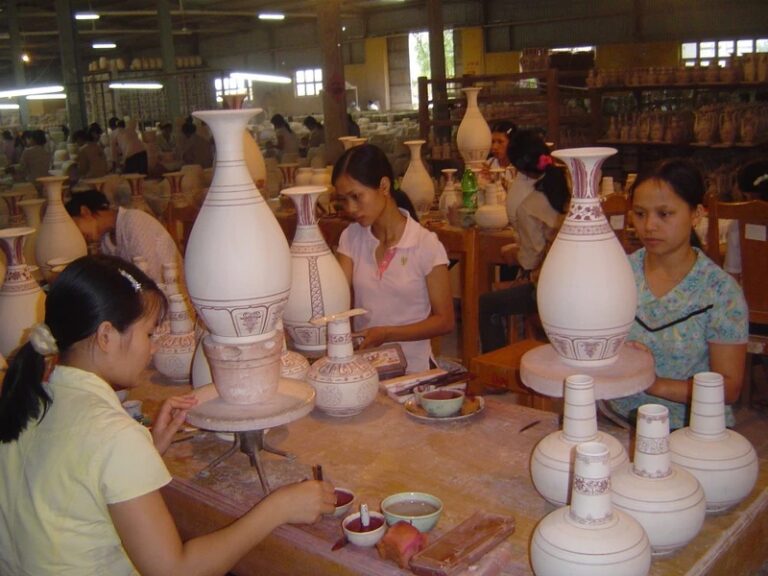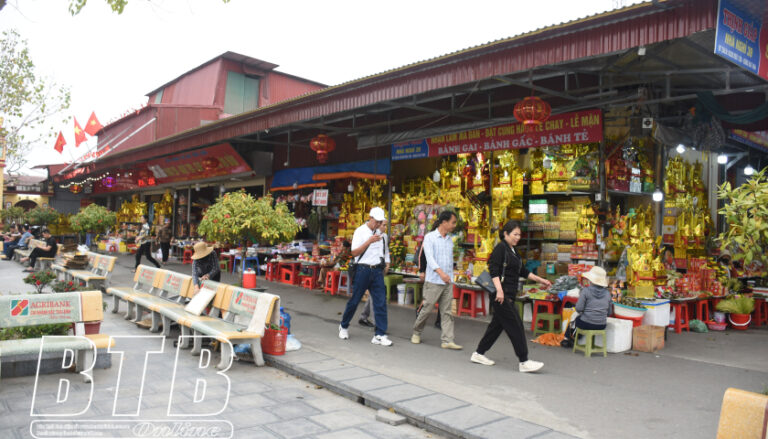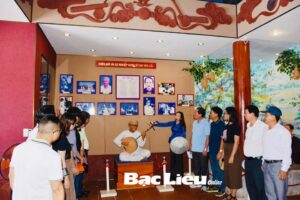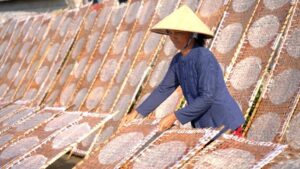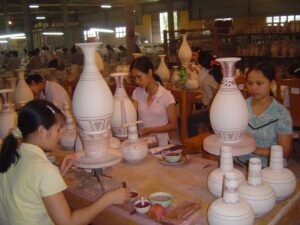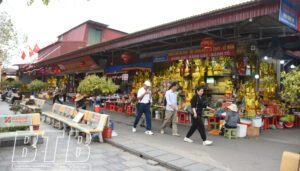Leaving the guest house situated on Nguyen Hue Street, I went to the market in tranquil Hoi An in the early morning.
st1:*{behavior:url(#ieooui) }
It was drizzling; the streets were not crowded. Some pupils were going to school; some people were sitting drinking coffee at the corner of Phan Chau Trinh and Nguyen Hue Streets. From time to time I saw a motorcyclist carrying goods to the market.
Hardly any shops were open. On the pavement of Nguyen Hue Street near the market, some people were displaying their goods, such as vegetables, dry green bean cakes, muffins (specialties of the Ancient Town), and coconut candy.
Also on the pavement, a woman was displaying her ceramic items, ready to welcome customers. Dang Thi Thong, 41 years old, is the mother of 11 and has been stuck on the same spot for the last 18 years. She sells various ceramic items for souvenirs.
Her products were bought from Hanh Ha Ceramics Village, about a 5-7-minute motorbike ride from the center of Hoi An.
About 500 years ago, that village was at its peak of prosperity, well-known for its ceramic and terracotta products sold throughout Central Vietnam. The trade disappeared into obscurity but in the past 20 years, the ceramic craft has been restored thanks to the tourist boom.
Mrs. Thong said: “This is a traditional craft, so the authorities in Hoi An allow the goods to be sold on the pavements. Five other sellers are with me. Each of us has to pay a tax of only VND100,000 per month.”
It seems that Hoi An in the early morning belongs to hard-working people. Mr. Nguyen Duong, 82, has to carry water in town, a job he’s been doing for two decades; for every two buckets of water he gets VND5,000 and tips.
Although struggling to survive Mr. Duong’s family isn’t classed as poor. According to the government’s stipulations on the standards of urban poor households from 2011 to 2015, a poor household means the one whose average income per family member must be under VND500,000 a month.
Mr. Duong’s family is actually classed at “trading in transport” (his son with a mental illness carries water too), and can earn more than VND1 million a month. It is utterly pitiful for old men like him to be working at all.
Mr. Duong said that he gets the water from the Ba Le Well. The water from Ba Le Well is specially used for rice noodles, cao lau noodles, and making coffee.
On the way to Chua Cau (Japanese Bridge) from Tran Phu Street, many ancient houses near the Market are seen with bougainvillias stretching out towards the street.
On Tran Phu Street, besides stores with souvenirs and fabric there are a number of bistros and eateries. Trung Bac bistro, which is rather well-known, used to sell only cao lau, but now it has branched out to wonton soup, dumplings, meat pies, Vietnamese pancakes, chicken rice, even pizza and spaghetti for the tourists.
Cao Lau is a typical foodstuff of Hoi An. It consists of long yellow noodles, roast pork, vegetables, and some bouillon. The noodles are made from rice mixed with Ba Le water and ash of cajuputs from the Cham isle. The mixture must be steeped, ground, pressed, boiled, kneaded, rolled, steamed, and finally cut into strands. It is meticulous and difficult to make but worth the effort for a fabulous end result.
Lastly, I came across Mrs. Ngo Thi Luyen’s plain rice flans and wrapping cakes. The flan is made from rice flour with shrimp and meat stuffing; the wrapping cake consists of only meat stuffing wrapped in banana leaves. Her cakes were not expensive either – a real bargain at VND5,000 each explaining why her profit target of VND100,000 is so low but she was happy. In fact all these people put in a hard shift for little gain but still smiling and those people made for an eventful morning in Hoi An.
By Ngoc Tran in Hoi An
st1:*{behavior:url(#ieooui) }


